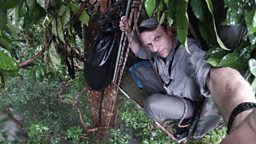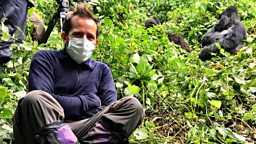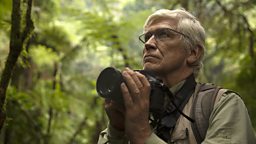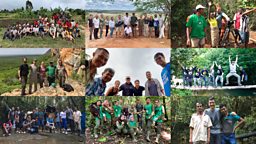Protecting primates through ecotourism
Dr Russell Mittermeier is a world renowned primatologist, Global Wildlife Conservation’s Chief Conservation Officer and chairman of the IUCN Species Survival Commission Primate Specialist Group.
Right now, half of the world’s primates are under threat, but Russ is on a mission, to show how ethical tourism might help protect some of the World’s rarest species.
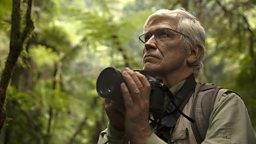
Meet Russ
As of this year, I will have been studying and observing primates in the wild for exactly 50 years. I owe my lifelong love of wildlife in part to my mother, who had a passion for wildlife that she instilled in me as a child growing up in New York, mainly by taking me to the Bronx Zoo and the American Museum of Natural History many times beginning at a very early age. The other big influence in my life was the story of Tarzan, which drove me to seek adventure in the world’s wild places, and especially in rain forests. Indeed, in the first grade, when asked by my teacher what I wanted to be when I grew up, I immediately replied “Jungle Explorer”. Not much has changed since then.
just since 2000 we have described fully 95 new species of primatesDr Russell Mittermeier
Why Primates?
I am often asked why I am so interested in primates. First of all, they are some of the best symbols for tropical rainforests where more than 90% of them are found. What is more, they are our closest living relatives, and are a particularly diverse and interesting group of animals in terms of their behaviour and ecology. But I also work on them because they are cool, cute, endearing, and generally fun to search for and to observe.
I have spent a good part of my career trying to figure out exactly how many different kinds of primates exist, and trying to see as many of them as possible in their natural habitats. At present, there are a total of 79 genera, 514 species and 708 different taxa (species and subspecies combined) of primates. Indeed, it is amazing when we realise that just since 2000 we have described fully 95 new species of primates, and we know for certain that quite a few more remain to be described. It’s an exciting time.
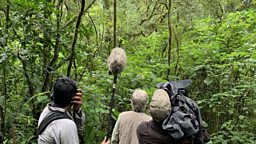
The problems for primates
Unfortunately primates are severely threatened almost everywhere that they occur, especially by the rampant destruction of their tropical forest homes. What is more, primates are hunted as a source of food, for sport, and often for live capture as pets or for medicinal purposes. Hunting of primates for their meat is widespread in many parts of the tropics to the point that primates are even a preferred food in some regions.
it [ecotourism] is one of the most effective tools… to ensure their long-term survivalDr Russell Mittermeier
This combination of threats has led to primates becoming the most endangered larger group of mammals, with more than 60% of all known species now classed as Critically Endangered, Endangered or Vulnerable. The highest concentration of threatened primates is unquestionably on the island of Madagascar, which has 111 species and subspecies all of which are endemic and found nowhere else in the world. This makes Madagascar clearly the world’s single highest major primate conservation priority. But there are many other priority regions as well, including Amazonia, the Atlantic forest region of eastern Brazil, the Guinean Forests of West Africa, the Congo forests of Central Africa, and both mainland and insular Southeast Asia.
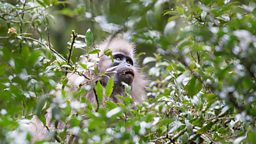
A solution?
Over the course of my lifetime, I have seen both encouraging success stories and dramatic losses of primates.
I have been a primate-watcher and primate life-lister since I saw my first spider monkey in the Mayan ruins of Tikal in Guatemala back in 1970, and I have never let up.Dr Russell Mittermeier
Indeed, it is hard to generalize across the board because the situations vary so greatly. But the fact is that we as a conservation community have learned over the years how to conserve primates, and we have many examples of how this can be done. Many different actions are needed to achieve our goal of Zero Primate Extinctions in this century. Here I would like to focus on only one of them: primate ecotourism.
I first began to promote primate ecotourism about 20 years ago, basing it on the birdwatching model - it is a major economic driver. More than 50 million people in the USA are birdwatchers, and the industry there alone is valued at more than $50 billion. At a global level, it would be much more. So I thought, why not try to do something similar, albeit it at a smaller scale, for primates.
Primate-watching and life-listing
Since several models for primate-watching already existed, of which Mountain Gorilla tourism in Rwanda and Uganda is the oldest and most successful, I decided to develop primate-watching and primate life-listing as a new endeavour. We have produced a wide variety of materials, including field guides, pocket guides, posters, stickers, t-shirts, and, most recently, an App for lemur-watching in Madagascar. What is more, I have used my own primate life-list, now at more than 400 species and subspecies, as a stimulus to engage others. In fact, I have been a primate-watcher and primate life-lister since I saw my first spider monkey in the Mayan ruins of Tikal in Guatemala back in 1970, and I have never let up.
Early on, I realised that it would be almost impossible to see all primates in the wild in my lifetime, so I set myself a more achievable goal – to be the first to see all 79 genera in the wild. And I am delighted to announce that as of April, 2019, I became the first person ever to achieve this when I saw number 79, the Kipunji (Rungwecebus kipunji), in the wild in the mountains of southern Tanzania. This was accomplished thanks to my good friend Tim Davenport of the Wildlife Conservation Society, who discovered and described this new genus in 2005. What is more, I had the great good fortune to have 91�ȱ� along to film this encounter, and to include in the Primates series.
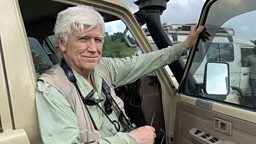
So what does primate ecotourism and primate-watching mean for primate conservation?
it [ecotourism] dramatically changes the way local people perceive the value of primates.Dr Russell Mittermeier
Well, actually it is one of the most effective tools that we have available to ensure the long-term survival of these animals in their natural habitats. To begin with, it dramatically changes the way local people perceive the value of primates. They begin to realise that primates can provide economic benefits to them, and that conserving them, as opposed to hunting them for food or destroying their habitat, can have a major impact on their own lives. And it can quickly lead to the creation of local guide associations, hotels to house visitors, and all the other service activities associated with tourism. It can also become a source of local pride when people realise that they are the only ones in the world who have these species in their forests and that they are responsible for their long-term survival. This is not conjecture. It works, and I have seen it work over and over again in many different cultural settings and in every region where primates occur.
Clearly, this is not the only thing needed to save primates. But I have found that it can be the fastest way to change behaviours and generate revenue, first at local levels and then, in cases like that of the mountain gorilla, at national levels - to the point that even central governments take notice.
What is the future for primates in the wild?
Well, in spite of all the challenges that we face, I am optimistic that we will be able to save representative populations of all primate species around the world. We need to be creative, we need to be deeply committed, we need greater public awareness of their importance and their plight, and we need more resources to implement the conservation action plans that we already have available. In light of this, I am especially pleased that 91�ȱ� has chosen to include primate conservation, and a segment on primate ecotourism, in the new 91�ȱ� One Primates series.
Well, in spite of all the challenges that we face, not least the outbreak of Covid-19, I am optimistic that we will be able to save representative populations of all primate species around the world.

Conservationist on mission: A world first
International primatologist Russell Mittermeier is searching for the rare kipunji monkey.
